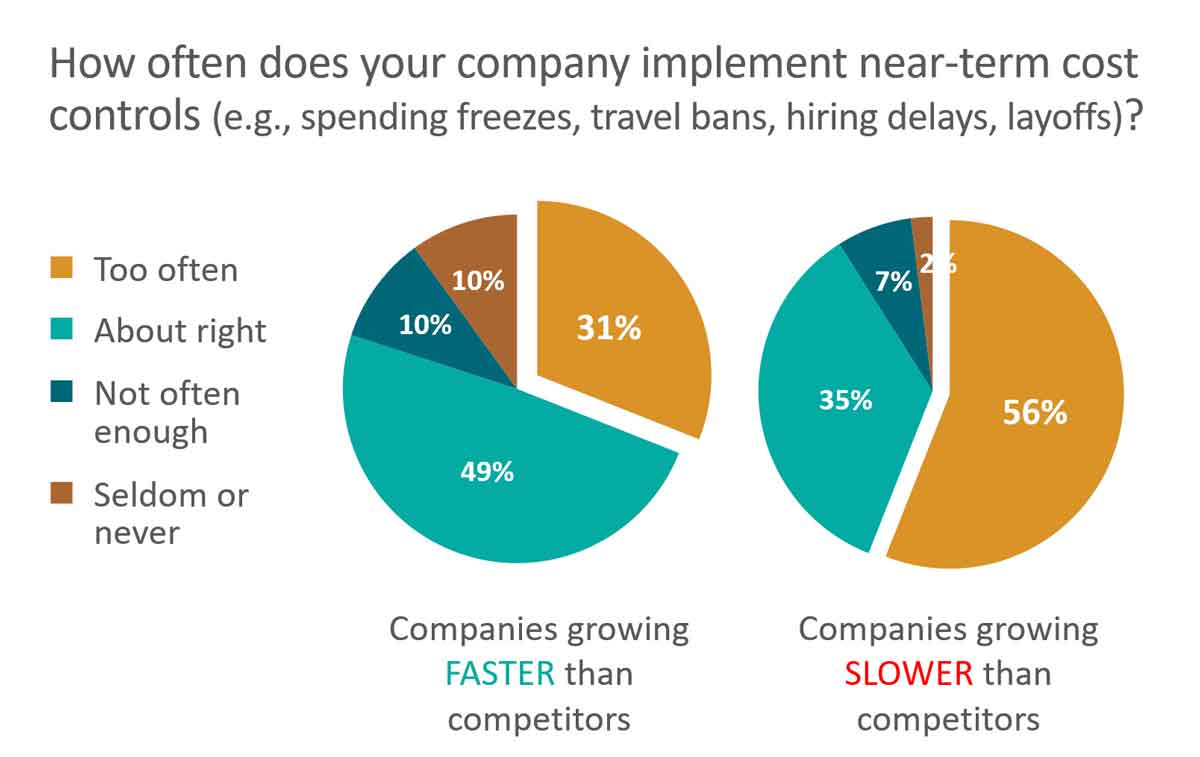How cost controls put the brakes on your business growth

If you work inside a corporation, there’s a good chance you’re familiar with near-term cost controls: spending freezes, travel bans, hiring delays, layoffs, and so forth. Maybe you’re a business leader who has implemented these. But… have you considered the price you pay for them? Let’s see why it may be higher than you think.

In the recently published book, Business Builders: How to Become an Admired and Trusted Corporate Leader, four types of senior business leaders were examined: Builders, Decorators, Remodelers, and Realtors. A survey with 654 responses was conducted to support the book’s findings.
The survey asked respondents about the behaviors of their senior business leaders. We saw a stark contrast between two leadership styles in particular: Builders and Decorators. We didn’t use these terms in the survey (to prevent bias), but rather asked survey respondents to characterize the “primary passion” of their leaders as follows:
- Driving organic growth by delivering differentiated value to customers. (Builder)
- Presenting favorable financial performance and outlook to investors. (Decorator)
Compared to Builder-led companies, employees at Decorator-led companies reported:
- Weaker growth vis-à-vis competitors.
- Lower expectations for future business growth.
- Too much leadership focus on near-term results.
- Too frequent use of near-term cost controls.
Cost controls and long-term growth
The last item—too frequent use of near-term cost controls—caught our eye. Over the years, we’ve heard many complaints from employees about this. One discouraging refrain around mid-year: “We need to do this work now because management always enacts cost controls at the end of the year.”
“We need to do this work now because management always enacts cost controls at the end of the year.”
So we were curious: Is there a correlation between the use of these cost controls and longer-term growth? Turns out there’s a very strong correlation. Respondents were asked how often their companies implemented such cost controls. As you see in this chart, the result for companies growing faster than competition was reasonably balanced. (Although even here, more people said, “too often” than “not enough.”)

The result for companies growing slower than competitors was alarming: Here, 56% of the employees reported that cost controls were implemented too often. Granted, this shows correlation, not causation. But for any company interested in growing faster than its competitors, cost controls should cause concern.
First and second order effects
Consider first and second order effects. An example comes from the early 1900s in French-controlled, colonial Hanoi. They faced an exploding rat population, so they placed a bounty on rat tails turned in. The first order effect was lots of rat tails turned in. Great news, right?
But there were two second order effects. First, they noticed many tailless rats in the city, as residents favored amputation over extermination. Second, several rat-breeding farms were opened.

Whenever you change a system to deliver a first order effect, you will always have a second order effect. If your first order effect was desirable, your second order effect will usually be undesirable. And vice versa.
You see this all the time. Enjoying unlimited jelly-filled donuts (first order effect) is more fun than ill-fitting clothes later (second order effect). Grinding through daily exercise (first order effect) is hard, but it lets you keep up with your grandkids (second order effect). Champion weightlifter and poet Jerzy Gregorek provided us with this simple formula: “Easy decisions, hard life. Hard decisions, easy life.”
First domino fixation
What does this have to do with cost controls? When you take this action, you may think you’re tipping just one domino, but there’s always a second domino that will tip later. And more dominos after that.
When you take this action, you may think you’re tipping just one domino, but there’s always a second domino that will tip later.
Consider how this applies to your business. You’re nervous about the financial results for the coming quarter, so you freeze discretionary spending with cost controls. Good news: You meet this quarter’s earnings target. But your cost controls also slowed dozens of new product projects as teams waited to run outside lab tests, hire technicians, interview customers, and so on.
Product launches are pushed back as a result and this delays future revenue, leading to poor revenue and earnings growth. This is not the profitable, sustainable growth you had hoped for.
What do you do now? More cost controls? Business leaders are clever about many things, but they often suffer from first domino fixation. They’re only thinking about that first domino.
First domino amnesia
Unfortunately, most business leaders don’t learn from their experience. Ever sit through a financial review where the leadership team laments poor earnings growth? How often have you heard one of them say, “Well our problem today is all those crazy cost controls the last few years”? Never?
I call this first domino amnesia. A short time horizon works both ways: Leaders fail to look far enough into the future to foresee the impact of their decisions. And they fail to look far enough into the past to understand the cause of their problems. A lack of foresight and understanding can’t be a good thing.
A lack of foresight and understanding can’t be a good thing.
Are you creating your own growth friction?
Recall the earlier conversation in which employees could “plan” on their management enacting end-of-year cost controls. It’s reasonable to expect a rainy season in Cambodia, but what does it say when employees can predict a business slow season their leaders arbitrarily impose?
A rainy season brings mud, which turns forward progress into a slog. Same with near-term cost controls. If an executive edict is likely to slow market-facing innovation, leaders have introduced growth friction.
This is a handicap on growth business leaders have chosen to self-impose. The most obvious forms are near-term cost controls such as travel bans, spending freezes, hiring delays, and layoffs.
But growth friction also occurs when a restless leadership team makes any change too frequently. Rapid shifts in organizational structure, job responsibilities, company-wide initiatives, and strategy may be well-meant, but they’re still disruptive.
What’s a Builder to do?
So are most senior leaders in favor of these near-term cost controls? Here’s the shocker: A slightly higher percentage of senior leaders said these cost controls were too frequent, compared to their subordinates. Just consider that: more leaders are unhappy with these cost controls than their subordinates… and yet they are calling for them!
More leaders are unhappy with these cost controls than their subordinates… and yet they are calling for them!
This leads to an obvious practical step for the Builder. There are many things “to do” if you want to be a renowned Builder. But you can start by not doing what others too often do: rely on near-term cost controls. Say no thanks to that jelly-filled donut.
Let your market-focused innovation teams do their best work in an unfettered manner. Let them sprint on dry ground without creating a muddy obstacle course for them. And hope your competitors keep enacting near-term cost controls.
Are you a Business Builder?
You don’t have to be a senior business leader to be a Business Builder. In fact, if you wait until then to develop the experience and mindset… you’ll probably be too late. Business Building is hard work, and is done best by those with strong convictions.
You can take this free 5-minute assessment to see how well your beliefs align with those of Business Builders.
Go to www.AreYouABusinessBuilder.com and answer 20 questions.
You can download a confidential report with your overall Business Builder Score (100 max), and explanations of the 20 Business Builder beliefs behind each of the assessment questions.




Comments